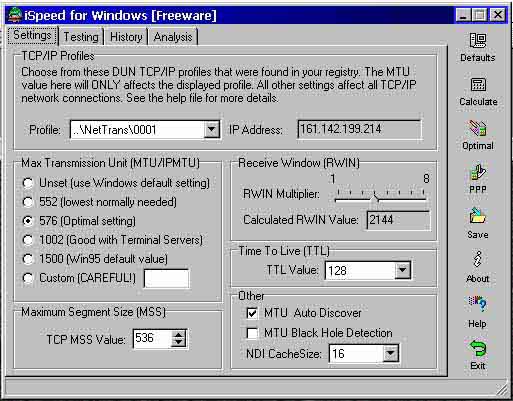 |
|
|
|
In the Forums... |
Written By: Keith "Farrel" McClellan Posted: February 19, 2000 Optimizing Other TCP/IP Settings Windows 95 Modem: After drivers, optimizing your network settings is the most important step in tweaking your LAN or modem. I personally recommend using iSpeed from High Mountain Software for tweaking your modem. Not only have I found it the easiest program to use, but it is the only program I have found that supports the NDI Cachesize setting.  MTU (Maximum Transmittable Unit): This setting is imperative for optimal packet transmission, for if it is set correctly, it will stop the information from being broken up during the transfer. MSS (Maximum Segment Size): This is the largest amount of data that can be sent in one transmitted unit. The rest of the packet is reserved for the header, which includes destination information as well as other information. An unconfirmed rumor that is going around recently states that Windows 98 doesn't use this setting because it determines the MSS dynamically. However, even if this is correct, inputting this setting will in no way be detrimental to the system. RWIN (Receive Window) Multiplier: This setting determines how many packets are transmitted before the system determines the integrity of the data transfer. Raising this setting will increase modem speed at the price of possible packet loss. Generally, a good multiplier is 4x, but if you have particularly clean, or bad, phone lines, you may want to adjust the setting accordingly. TTL (Time to Live): This setting determines how many "hops" the computer will allow before it closes the connection. A low number, such as 32, will slightly increase performance, but a higher number, such as 128, will allow you to reach sites that are having connection problems (such as when a pipeline goes down and the information has to be rerouted through another system). MTU Auto Discover: Even though you calculate your MTU using your ISP, sometimes other sites will be connected to the Internet using an even lower MTU. In these situations, Auto Discover comes into play. It will determine the optimal MTU for that particular site so that your information has to be fragmented as little as possible. NOTE: This is only a Windows 98 feature - it doesn't do anything for Windows 95 users, so leave it disabled. Black Hole Detect: This setting enables the computer to determine some reasons for packet loss. This setting, however, is not recommended because it will dramatically lower performance. Better to just leave it off. NDI Cachesize: The NDI cachesize is a networking setting and won't directly affect your Internet connection, but if you are connected to a network you should set it to 16 or 32. |
||
|
| |||
|---|---|---|---|